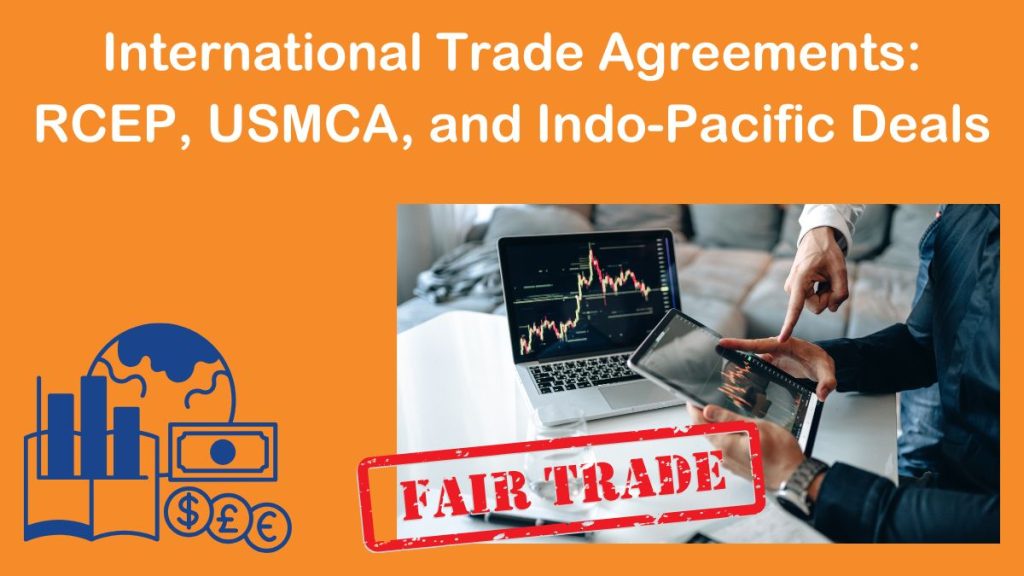International trade agreements play a crucial role in shaping the global economy by promoting trade liberalization, reducing tariffs, and enhancing economic cooperation among nations. For students preparing for competitive exams, understanding these agreements—such as the Regional Comprehensive Economic Partnership (RCEP), the United States-Mexico-Canada Agreement (USMCA), and Indo-Pacific trade deals—is essential. These agreements not only impact global trade but also influence economic policies, diplomatic relations, and employment opportunities across countries. Read our blog to know more about the different trade deals and how they impact the Indian economy

Regional Comprehensive Economic Partnership (RCEP)
The Regional Comprehensive Economic Partnership (RCEP) is a landmark free trade agreement among 15 Asia-Pacific countries, including the 10 ASEAN nations—Brunei, Cambodia, Indonesia, Laos, Malaysia, Myanmar, the Philippines, Singapore, Thailand, and Vietnam—along with China, Japan, South Korea, Australia, and New Zealand. Signed in November 2020, RCEP officially came into effect on January 1, 2022, creating the world’s largest trade bloc.
RCEP covers nearly 30% of global GDP and population, making it a significant force in global trade. The agreement aims to eliminate tariffs on 90% of traded goods over the next two decades, fostering greater market access. The agreement has major economic implications. It strengthens Asia-Pacific economies by boosting trade and investment flows while consolidating China’s position as a dominant force in global trade. However, India chose to opt out over concerns about cheap imports affecting domestic industries. Despite this, the possibility of India joining in the future remains open.
United States-Mexico-Canada Agreement (USMCA)
The United States-Mexico-Canada Agreement (USMCA) replaced NAFTA and came into effect on July 1, 2020, modernizing trade relations among the three North American nations. It strengthens regional economic ties through updated provisions across multiple industries.
One of USMCA’s key features is its impact on the automobile industry, requiring that 75% of a vehicle’s parts be manufactured in North America for tariff-free trade. It also enforces higher wages for auto workers in Mexico and improves labor protections. The agreement expands U.S. access to Canada’s dairy market, benefiting American farmers. Additionally, USMCA enhances digital trade regulations, improving e-commerce and data privacy protections. It also strengthens intellectual property (IP) rights, particularly in the pharmaceutical sector, ensuring longer patent protections. The United States-Mexico-Canada Agreement (USMCA) boosts North American trade while protecting domestic industries. It encourages investment, particularly in the automobile sector, promoting regional economic growth.
Indo-Pacific Trade Deals
The Indo-Pacific region has become one of the most significant trade hubs in the world, with several trade agreements fostering economic partnerships and cooperation among key economies. Some of the most prominent trade initiatives include the Indo-Pacific Economic Framework for Prosperity (IPEF) and other regional agreements that enhance trade liberalization and investment flows.
The Indo-Pacific Economic Framework (IPEF) was launched in May 2022 by the United States as a strategic economic initiative to deepen engagement with Indo-Pacific countries. Apart from IPEF, several other trade initiatives play a crucial role in shaping economic interactions in the Indo-Pacific. The Comprehensive and Progressive Agreement for Trans-Pacific Partnership (CPTPP) is a significant trade agreement among 11 countries, including Japan, Canada, and Australia, which facilitates high-standard trade regulations and investment flows. Additionally, the India-Australia Economic Cooperation and Trade Agreement (ECTA) strengthens bilateral trade by reducing tariffs and promoting investments. Another key initiative is the India-ASEAN Free Trade Agreement (FTA), which enhances economic collaboration between India and ASEAN nations
The Indo-Pacific Economic Framework (IPEF) aims to counterbalance China’s dominance in regional trade while strengthening economic ties among member nations. It provides India with an opportunity to boost trade relations with developed economies, enhancing market access and investment prospects. Additionally, IPEF promotes sustainable trade practices by focusing on digital advancements and green technologies, ensuring long-term economic resilience and environmental responsibility in the Indo-Pacific region.
Comparison of RCEP, USMCA, and Indo-Pacific Deals
The Regional Comprehensive Economic Partnership (RCEP) comprises 15 Asia-Pacific countries and has a target for tariff cuts for 90% of traded goods, although it has few provisions for digital trade and labor standards. India is not a signatory to RCEP.
The United States-Mexico-Canada Agreement (USMCA), a replacement for NAFTA, mainly advantages particular sectors like automotive and dairy, with robust labor laws and digital trade provisions. India, however, has no role in this agreement.
The Indo-Pacific economic agreements, the Indo-Pacific Economic Framework (IPEF) with 14 members, feature transparency and digital trade over tariff cuts. India is an active member of IPEF, influencing policies concerning supply chains, clean energy, and fair economic practices.
Though RCEP focuses on liberalization of trade, USMCA is centered on sector-specific gains and workers’ protection, and IPEF encourages digital trade and economic openness, with varying strategic emphases in various global trade arrangements.
Summing Up
Understanding international trade agreements like RCEP, USMCA, and Indo-Pacific trade deals is essential for competitive exam aspirants. These agreements shape global trade, impact economic policies, and influence job markets worldwide. While RCEP strengthens regional cooperation in Asia, USMCA modernizes trade among North American nations, and Indo-Pacific trade agreements aim to balance economic influence in the region. Given India’s strategic importance, its participation in Indo-Pacific deals highlights its growing role in global trade dynamics. Keeping abreast of such developments will not only help students in exams but also provide insights into global economic trends.
ixamBee specializes in providing expert guidance and resources for banking exams 2024, ensuring that you are well-prepared for the Upcoming Bank Exams like RBI Grade B, NABARD Grade B, IBPS SO, and more. Our courses align with the bank exam calendar 2024, covering all the essential topics. With a focus on the upcoming bank jobs, our Previous Year Papers, BeePedia, SSC CGL, SSC CHSL, SSC MTS and other Mock Tests are designed to help you excel in upcoming banking exams.
Also Read:
National Symbols of India 2024: Learn Their Meaning and Significance